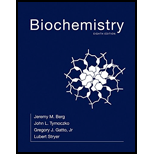
Interpretation:
The reaction which links the process of glycolysis, citric acid cycle also the enzyme involved in it needs to be explained.
Concept Introduction:
Answer to Problem 1P
Pyruvate dehydrogenase enzyme complex is required for the linking of glycolysis and TCA. It helps in the conversion of pyruvate into acetyl CoA. Acetyl CoA then enters into the series of the citric acid cycle.
Explanation of Solution
Glycolysis is a catabolic process. In this process, one glucose molecule is converted into two molecules of pyruvate. The energy released during this process is useful in the formation of high-energy adenosine triphosphate (ATP) molecules and reduced nicotinamide adenine (NADH) molecules.
The citric acid cycle is a catabolic process. It is also known as the Krebs cycle or TCA cycle. In this cycle, a series of
The reaction which links the process of glycolysis and citric acid cycle also, the enzyme involved in it is as follows:
Pyruvate dehydrogenase enzyme complex is required for the linking of glycolysis and TCA. It helps in the conversion of pyruvate into Acetyl CoA. Acetyl CoA then enters into the series of the citric acid cycle.
Want to see more full solutions like this?
Chapter 17 Solutions
Biochemistry
- Tracing glucose. Glucose labeled with 14 C at C-6 is added to a solution containing the enzymes and cofactors of the oxidative phase of the pentose phosphate pathway. What is the fate of the radioactive label?arrow_forwardInstructions. Given each set of information which may include common name(s) and the reaction catalyzed, you are required to identify the main class of the specific enzyme described. Name: citryl-CoA synthetase Reaction: ATP + citrate + CoA = ADP + phosphate + (3S)-citryl-CoA Name: D-xylulose reductase Reaction: xylitol + NAD+ = D-xylulose + NADH + H+ Name: cellobiose phosphorylase Reaction: cellobiose phosphate = α-D-glucose 1-phosphate + D-glucose Name: carbonic anhydrase Reaction: H2CO3 = CO2 + H2O Other info: The enzyme catalyzes the reversible hydration of gaseous CO2 to carbonic acid, which dissociates to give hydrogencarbonate above neutral pH. Name: pantoate activating enzyme Reaction: ATP + (R)-pantoate = AMP + diphosphate + (R)-pantothenate.arrow_forwardBIOCHEMISTRY. Could glycerol be used to regenerate the OAA for maintenance of TCA cycle activity? Yes or No? Explain.arrow_forward
- The last stop. The final electron acceptor for the electron-transport chain is which of the following? do a. 0202 b. Coenzyme Q с. СО2СО, d. NAD+NAD+arrow_forwardIn full details. Explain the significance of redox potentials formed by redox pairs in the electron transport chain.arrow_forwardDraw Gluconeogenesis. Please make sure to state all the enzymes and co-factors for each step of the pathway.arrow_forward
- Closely related. Pyruvate dehydrogenase complex and a-ketoglutarate a-ketoglutarate dehydrogenase complex are huge enzymes consisting of three discrete enzymatic activities. Which amino acids require a related enzyme complex, and what is the name of the enzyme?arrow_forwardNeed help ASAP. Describe the steps by which the F0 portion of the ATP synthase harnesses the proton-motive force to help synthesize ATP. What would you expect to observe if the proton gradient were reversed? Explain your answer.arrow_forwardRequired partner. Aminotransferases require which of the following cofactors: a. NAD+/NADP+NAD+/NADP+ b. Pyridoxal phosphate c. Thiamine pyrophosphate d. Biopterinarrow_forward
- Fo-F1 ATPase. The energy for ATP synthesis from ADP and Pi is provided by the downhill transport of protons through the rotary FoF1 ATP synthase (lecture 22). The enzyme has 3 a-b and 12 ‘c’ subunits. The mitochondrion maintains Df=180 mV (negative inside), pHin = 8, pHout=7, [Pi] = 3 mM and ADP is present as well. How much energy is available (from the proton electrochemical gradient) for ATP synthesis under these conditions (in kJ/mol)? What [ATP]/[ADP] ratio will be established at steady-state under these conditions? What would be the [ATP]/[ADP] ratio if the enzyme had only 9 ‘c’ subunits? Remember that full revolution of the crank (gamma subunit) produces 3 ATP.arrow_forwardFor 100 words. What are the two essential requirements to effectively carry out metabolic work?arrow_forwardFo-F1 ATPase. The energy for ATP synthesis from ADP and Pi is provided by the downhill transport of protons through the rotary FoF1 ATP synthase . The enzyme has 3 alpha-beta and 12 ‘c’ subunits. The mitochondrion maintains change in membrane potential=180 mV (negative inside), pHin = 8, pHout=7, [Pi] = 3 mM and ADP is present as well. . What [ATP]/[ADP] ratio will be established at steady-state under these conditions? What would be the [ATP]/[ADP] ratio if the enzyme had only 9 ‘c’ subunits? full revolution of the crank (gamma subunit) produces 3 ATP.arrow_forward
 BiochemistryBiochemistryISBN:9781319114671Author:Lubert Stryer, Jeremy M. Berg, John L. Tymoczko, Gregory J. Gatto Jr.Publisher:W. H. Freeman
BiochemistryBiochemistryISBN:9781319114671Author:Lubert Stryer, Jeremy M. Berg, John L. Tymoczko, Gregory J. Gatto Jr.Publisher:W. H. Freeman Lehninger Principles of BiochemistryBiochemistryISBN:9781464126116Author:David L. Nelson, Michael M. CoxPublisher:W. H. Freeman
Lehninger Principles of BiochemistryBiochemistryISBN:9781464126116Author:David L. Nelson, Michael M. CoxPublisher:W. H. Freeman Fundamentals of Biochemistry: Life at the Molecul...BiochemistryISBN:9781118918401Author:Donald Voet, Judith G. Voet, Charlotte W. PrattPublisher:WILEY
Fundamentals of Biochemistry: Life at the Molecul...BiochemistryISBN:9781118918401Author:Donald Voet, Judith G. Voet, Charlotte W. PrattPublisher:WILEY BiochemistryBiochemistryISBN:9781305961135Author:Mary K. Campbell, Shawn O. Farrell, Owen M. McDougalPublisher:Cengage Learning
BiochemistryBiochemistryISBN:9781305961135Author:Mary K. Campbell, Shawn O. Farrell, Owen M. McDougalPublisher:Cengage Learning BiochemistryBiochemistryISBN:9781305577206Author:Reginald H. Garrett, Charles M. GrishamPublisher:Cengage Learning
BiochemistryBiochemistryISBN:9781305577206Author:Reginald H. Garrett, Charles M. GrishamPublisher:Cengage Learning Fundamentals of General, Organic, and Biological ...BiochemistryISBN:9780134015187Author:John E. McMurry, David S. Ballantine, Carl A. Hoeger, Virginia E. PetersonPublisher:PEARSON
Fundamentals of General, Organic, and Biological ...BiochemistryISBN:9780134015187Author:John E. McMurry, David S. Ballantine, Carl A. Hoeger, Virginia E. PetersonPublisher:PEARSON





